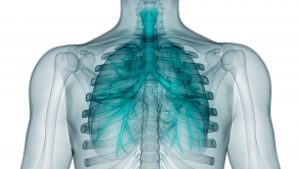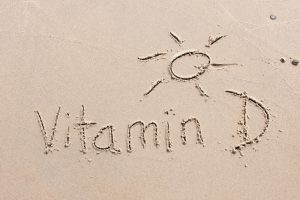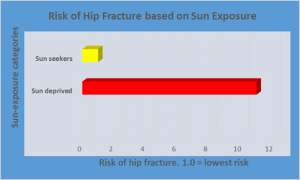A major research paper report in the medical journal, Pediatrics, has shown an alarming increase in vitamin D deficiency among children aged 0-17 years of age. https://www.ncbi.nlm.nih.gov/pubmed/28159871 [1] The researchers use the word “exponential,” and indeed it is, increasing from 3.14 deficient children per 100,000 in the year 2000 to 261 per 100,000 in 2014. We can state that as an 83-times increased risk of vitamin D deficiency, or an 8,300% increase. Either way one states it, it is an alarming increase, and will lead to an overwhelming number of bone diseases and other maladies in the future.
Why would such an increase take place?
That is an easy question to answer. Parents are “protecting” their children from sun exposure by keeping them away from direct sunlight—either by neglecting to take them outside (or demanding they stay indoors)—or slathering them with sunscreens, which can reduce the skin’s production of vitamin D by as much as 99%.[2] In the 1930s, when the medical community had not yet bought into today’s sun phobia, the Department of Labor printed a pamphlet called Sun for Babies in which they made this statement: “Every mother who wishes her baby to have robust health should give him regular sun baths from early infancy until he is old enough to play in the sun himself. If the sun’s rays are to help the baby grow properly and to prevent rickets, they must fall directly on the skin and tan it.” That would not be popular advice today, and it is likely any parent practicing “baby tanning” would be arrested for child abuse. Since the 1930’s the dermatological profession has come a long way… in the wrong direction. This is not to say that all dermatologists are sending the wrong messages. In my new book, Embrace the Sun (scheduled for publication shortly), I draw from the research from several “enlightened” dermatologists who have given stern warnings to their colleagues who are spreading their destructive, anti-sun messages. In fact, the person who is writing the foreword is a dermatologist, and one of the top sunlight/vitamin D scientists in the world.
Another chilling result of robbing our children of sunlight is the dramatic increase in myopia. There are several studies proving this point, but I will mention only one here: This research showed the prevalence of myopia among Chinese children living in Singapore was 29.1%, whereas Chinese children living in Sydney, Australia, had a prevalence rate of only 3.3%. The children in Sydney spent about 13.8 hours per week outdoors compared to 3.05 hours in Singapore. In other words, the children who spent most of their lives indoors, had 9.5 times the risk of developing myopia![3] In addition, rickets is now making a comeback. After a century of knowing how to prevent this disastrous children’s disease, it is returning, and cases of rickets are reported as far south as Texas, Georgia and North Carolina.[4] If children are not allowed to play outside, their vitamin D levels will be no better than if they lived at the North Pole.
But what about future risk of melanoma? Melanoma risk has increased by 3000% since 1935 while outdoor activity has decreased by about 90%.[5] The advice to halt the increase in melanoma, which is given by the melanoma foundations of course, is stay out of the sun and use more sunscreen. That is about as counterintuitive as it gets.
Protect your children from excessive sun exposure by using clothing and shade when they have had enough. Also be sure that the kids gradually and safely develop a protective tan. Never burn!
By Marc Sorenson, Ed.D. An advocate for the sun…Fighting vitamin D deficiency.
[1] Basatemur E, Horsfall L, Marston L, Rait G, Sutcliffe A. Trends in the Diagnosis of Vitamin D Deficiency. Pediatrics. 2017 Mar;139(3).
[2] Matsuoka LY, Ide L, Wortsman J, MacLaughlin JA, Holick MF. Sunscreens suppress cutaneous vitamin D3 synthesis. Journal of Clinical Endocrinology & Metabolism 1987; 64:1165-68.
[3] Rose KA, Morgan IG, J, Kifley A, Huynh S, Smith W, Mitchell P. Outdoor activity reduces the prevalence of myopia in children. Ophthalmology 2008 Aug;115(8):1279-85.
[4]Weisberg P, Scanlon KS, Li R, Cogswell ME. Nutritional rickets among children in the United States: review of cases reported between 1986 and 2003. Am J Clin Nutr 2004;80(6 Suppl):1697S-705S.
[5] Melanoma International Foundation, 2007 Facts about melanoma. Sources: National Cancer Institute 2007 SEER Database, American Cancer Society’s 2007 Facts and Figures, The Skin Cancer Foundation, The American Academy of Dermatology.
Vitamin D deficiency is increasing rapidly in spite of the fact more people are taking supplements than ever before. According to an article in the Daily Mail (UK), 75% or the U.S. population are deficient in Vitamin D, and among African Americans, 95% are deficient.[1] Recent research in the Journal of the American Osteopath Association places the blame for this deficiency squarely on two factors: (1) sun deprivation through sunscreen use, and (2) chronic diseases.[2]
The paper makes perfect sense. It is known sunscreen use can inhibit up to 99% of the production of vitamin D by the skin.[3] And of course, chronic diseases themselves may be the effect of sunlight/vitamin D deficiency. So, in trying to prevent sunburn and skin damage, we set ourselves up for a spate of illnesses.
Caution is the best prevention for sunburn. One should never stay out until the skin turns red, and in the beginning stages of sun exposure, one should gradually increase it until a tan develops. A tan is a sign the skin is protecting itself against burning. In a landmark paper published in 1993 in the journal Preventive Medicine, Dr. Gordon Ainsleigh stated, “As melanoma research has demonstrated, the best prevention is regular exposure, thereby maintaining a protective tan and high vitamin D blood and tissue levels.”[4] And we now know that sun exposure produces photoproducts beyond vitamin D, such as nitric oxide, endorphins, and serotonin. Staying out of the sun, or blocking its rays, are recipes for health disasters. Queensland, Australia has vigorously promoted sunscreen for decades, and Queensland now has one of highest rates of melanoma in the world,[5] along with a rate of vitamin D deficiency which is becoming critical.[6] The answer from the dermatologists, of course, is to prescribe more sunscreen and frighten more people out of the sun. Is that not the most counterintuitive decision of the century?
A much better choice than sunscreen is to simply leave the sun when it becomes too intense, or cover up with light, reflective clothing. Enjoy the sun, but do it carefully and never burn. And don’t destroy all the salubrious effects of the sun by using a noxious sunblock.
[1] http://www.dailymail.co.uk/health/article-4462730/Too-sunscreen-making-vitamin-D-deficient.html?ITO=1490&ns_mchannel=rss&ns_campaign=1490
[2] Pfotenhauer KM, Shubrook JH. Vitamin D deficiency, its role in heath and disease, and current supplementation recommendations. J Am Osteopath Assoc. 2017; 117(5):301 – See more at: http://www.ajmc.com/newsroom/sunscreen-use-chronic-disease-linked-to-vitamin-d-deficiency#sthash.Yfx4Rbny.dpuf
[3] Matsuoka LY, Ide L, Wortsman J, MacLaughlin JA, Holick MF. Sunscreens suppress cutaneous vitamin D3 synthesis. Journal of Clinical Endocrinology & Metabolism 1987; 64:1165-68.
[4] Ainsleigh G. Beneficial effects of sun exposure on cancer mortality. Preventive Medicine 1993;22:132-140.
[5] Garland CF, Garland FC, Gorham ED. Could sunscreens increase melanoma risk? American Journal of Public Health, Vol. 82, No. 4, April 1992, pp. 614-15.
[6]Van der Mei IA, Ponsonby AL, Engelsen O, Pasco JA, McGrath JJ, Eyles DW, Blizzard L, Dwyer T, Lucas R, Jones G. A high vitamin D insufficiency across Australian populations and latitude. Environmental Health Perspect 2007;115:1132-39.
By Marc Sorenson, EdD, for sun exposure and children’s health…
It is well-known that sun exposure is associated with a reduced risk of many major cancers in adults. But what about children? A California study has shown that sun exposure during pregnancies also influences the childhood cancer risk of children who are a result of those pregnancies.[1] In this research, sun exposure, based on the geographical area where the women lived while pregnant, was measured. Then their children were compared in terms of childhood cancer risk, based on high or low sun exposure. Those children whose mothers experienced more sun exposure were less likely to develop acute lymphoblastic leukemia, hepatoblastoma, and non-hodgkin’s lymphoma. The authors of the study make this summary statement: “Our findings suggest that UVR during pregnancy may decrease the odds of some childhood cancers. Future studies should explore additional factors that may be correlated with UVR exposure and possibly include biomarkers of immune function and vitamin D.”
We have discussed in previous blogs the association of sunlight deficiency during women’s pregnancies and the subsequent risk of profoundly increased autism in their children. Therefore, similar results with cancer are not surprising. Safe, non-burning sun exposure has positive effects on at least 100 of the most frightening diseases, many of which will be discussed in my upcoming book that is coauthored by Dr. William B. Grant, and entitled Embrace the Sun. Children, even babies, need at least some sun exposure. And children, if they do not get outdoors in the sun are also subject to a remarkable increase in the risk of myopia.[2]
Take care of your children. Be sure that they play in the sunlight each day, without sunscreen. If any reddening occurs, put them in the shade or cover them up. But don’t deny them their share of sunshine; if you do, their risk of childhood cancers may increase.
[1] Lombardi C, Heck JE, Cockburn M, Ritz B. Solar UV radiation and cancer in young children. Cancer Epidemiol Biomarkers Prev. 2013 Jun;22(6):1118-28.
[2] Rose KA, Morgan IG, J, Kifley A, Huynh S, Smith W, Mitchell P. Outdoor activity reduces the prevalence of myopia in children. Ophthalmology 2008 Aug;115(8):1279-85.
Sun exposure and health… by Dr. Marc Sorenson, Sunlight Institute…
Lack of vitamin D, which is produced by sun exposure, leads to rickets, osteoporosis, osteomalacia and other bone diseases. In addition, research well after the first discovery of vitamin D has shown that vitamin D deficiency and sunlight deprivation also lead to many cancers, heart disease and multiple additional maladies. Now, as the world has modernized, the population is moving indoors, and even in the areas that are sunny throughout the year, sunlight exposure and vitamin D deficiency is increasing, both in rural and urban populations. The bones become so weakened without regular sun exposure, that the slightest movement may cause a fracture. As an example, the mother of an acquaintance of mine—a woman who avoided the sun—turned over in bed one night and broke her hip. Osteoporosis often destroys all quality or life for those who suffer it.
The importance of the sun in maintaining and producing strong bones has been known since antiquity. Dr. Richard Hobday, author of The Healing Sun, writes the following comments along with a history in an online article.[1] “Traditionally, sunlight deprivation has been linked with weak or brittle bones. One of the earliest references to this was made more than two thousand years ago by the Greek historian Herodotus (480-425 BC), who noted a marked difference between the remains of the Egyptian and Persian casualties at the site of battle of Pelusium which took place in 525 BC:
‘At the place where this battle was fought I saw a very odd thing, which the natives had told me about. The bones still lay there, those of the Persian dead separate from those of the Egyptian, just as they were originally divided, and I noticed that the skulls of the Persians were so thin that the merest touch with a pebble will pierce them, but those of the Egyptians, on the other hand, are so tough that it is hardly possible to break them with a blow from a stone. I was told, very credibly, that the reason was that the Egyptians shave their heads from childhood, so that the bone of the skull is indurated by the action of the sun — this is why they hardly ever go bald, baldness being rarer in Egypt than anywhere else. This, then, explains the thickness of their skulls; and the thinness of the Persian’s skulls rests upon a similar principle: namely that they have always worn felt skull -caps, to guard their heads from the sun.’
Herodotus, ‘The Histories’”
And here is a perhaps the transcendent study on hip fracture and sun exposure: research in Spain showed that women who were sun seekers had only about one-eleventh the risk of hip fracture as those who stayed indoors[2] (See the chart below).
That is very powerful evidence of the efficacy of sun in preventing weak bones. In stark contrast to this research are studies done on women who completely avoid the sun and suffer from osteomalacia. Osteomalacia is a soft-bone disease known as adult rickets, resulting from severe vitamin D deficiency, which deficiency prevents bone from properly mineralizing. Women who seldom go outdoors, or who are nearly always fully covered with clothing, have an extremely high incidence of osteomalacia at a very young age, even if they live in geographical areas with abundant sunlight.[3] [4] If one is never exposed to the available sun, the sun will not be able to produce its beneficial effects on the body, so one may as well live at the North Pole.
Sunbed use also is associated with stronger bones and higher vitamin D levels. An excellent study compared 50 people who used sunbeds regularly with 106 who did not.[5] The sunbed group had 90% higher vitamin D, significantly higher bone density and lower PTH levels (high PTH levels are associated with lower bone mass). The users had healthful vitamin D levels of 46 ng/ml [115 nmol/L] compared to only 24 ng/ml [60 nmol/L] for those who did not regularly use sunbeds.
Scientists at one time believed that sunlight and vitamin D were good only for preventing rickets, osteoporosis and other bone weaknesses. That belief has been supplanted by myriad research studies that show the efficacy of both sun exposure and vitamin D repletion on protection against numerous additional diseases. Nevertheless, we should never forget the extraordinary, never-changing value of sun exposure to maintaining a strong skeleton well into old age.
[1]Richard Hobday. The Healing sun: Sunlight, Brittle Bones, and Osteoporosis. http://sunlightenment.com/the-healing-sun-sunlight-brittle-bones-and-osteoporosis/. (accessed February 5, 2016)
[2] Larrosa M, Casado E, Gómez A, Moreno M, Berlanga E, Ramón J, Gratacós J. Vitamin D deficiency and related factors in patients with osteoporotic hip fracture. Med Clin (BARC) 2008;130:6-9.
[3] Sahibzada AS, Khan MS, Javed M. Presentation of osteomalacia in Kohistani women. J Ayub Med Coll Abbottabad 2004;16:63-5
[4] Al-Jurayyan NA, El-Desouki ME, Al-Herbish AS, Al-Mazyad AS, Al-Qhtani MM. Nutritional rickets and osteomalacia in school children and adolescents. Saudi Med J 2002;23:182-85.
[5] Tangpricha V, Turner A, Spina C, Decastro S, Chen TC, Holick MF. Tanning is associated with optimal vitamin D status (serum 25-hydroxyvitamin D concentration) and higher bone mineral density. Am J Clin Nutr. 2004 Dec;80(6):1645-9.
By Marc Sorenson, for sun exposure and health
Tuberculosis (TB) is an infectious disease that has caused the death of millions of people, especially in the early part of the 20th Century, but evidence of TB infections date back to about 8,000 BC. The CDC estimates that one-third of the world’s population is infected with TB and that there are about 1.5 million deaths yearly from this lethal disease.[1]
Drugs have done wonders to help, but have not been effective in the complete eradication of TB. However, there is a treatment that has been shown to be effective in nearly 100% of cases, and that treatment is sun exposure. Sun therapy (heliotherapy) was used in the early 20th Century to effectively treat TB patients, and Dr. Aguste Rollier’s records of 1,129 surgical TB cases showed that heliotherapy cured 87% of “closed cases” and 76% of “open cases.” Among 158 patients with tuberculosis of the hip, 125 were cured and 102 “regained complete recovery of articular function.”[2] And according to one source, “During one period of time just following World War 1, 1,746 of the 2,167 tubercular patients who were under Rollier’s care completely recovered health. The only failures were among those who had allowed their tuberculosis to enter its most advanced stages.”[3]
It is worthy to note that the first case of drug-resistant TB has arrived in the US from Peru.[4] It is nearly 100% resistant to antibiotics and does not bode well for the country, since it could cause an immense killer epidemic. There seems to be no answer to the “superbug” that causes it. Or is there an answer? Could sun exposure provide answers to this latest health threat? The superbugs are upon us like a bad horror movie, and when they start to take over the earth, there will be one solution: UV light from sun exposure or sun lamps. We would be well advised to have our defenses set up in advance by enjoying daily sun in the early morning and at midday.
The latest research simply shows what we have known for a century. A study conducted in Chile on the prevalence of sun exposure compared to the incidence of TB, shows that there is an independent and highly significant inverse association between sun exposure and TB incidence rate. In other words, the greater the sun exposure, the lesser the risk of contracting TB.[5]
So, we have defined one more disease here that can be nearly eradicated by sunshine, not drugs. We must safely embrace the Sun to live our lives in good health.
[1] http://www.medicinenet.com/tuberculosis_tb_facts/page2.htm
[2] Clark, W. Treatment of Bone and joint tuberculosis with Tuberculin and Heliotherapy. Journal of Bone and Joint Surgery 1923;5:721-39.
[3] Fielder, J. Heliotherapy: the principles & practice of sunbathing. Soil and Health Library (online) http://www.soilandhealth.org/index.html
[4] http://www.sphere.com/nation/article/first-case-of-highly-drug-resistant-tuberculosis-in-us/19294836?icid=main|htmlws-main-n|dl1|link3|http%3A%2F%2Fwww.sphere.com%2Fnation%2Farticle%2Ffirst-case-of-highly-drug-resistant-tuberculosis-in-us%2F19294836
[5] Balcells ME, Cerda J, Concha , Hoyos-Bachiloglu R, Camargo C, Martineau A, Borzutzky A. Regional solar radiation is inversely correlated with incidence and severity of tuberculosis in Chile. Epidemiol Infect. 2017 Apr 3:1-9. doi: 10.1017/S0950268817000607. [Epub ahead of print]
By Marc Sorenson, EdD for sun exposure and health…
The Vitamin D Society of Canada has just released one of the best articles on the relationship of sun exposure and its potential for vitamin D production. Sun exposure is the natural way to obtain your essential vitamin D, and of course provides other essential photoproducts such as nitric oxide, serotonin, endorphin and BDNF.
Here is the press release from the Vitamin D Society, in full:
NEWS RELEASE
For Immediate Distribution
TORONTO, Ont (April 4, 2017) – The daylight hours are getting longer, the sun is getting stronger and summer is just around the corner. Make this the year that you optimize your vitamin D levels through effective sun exposure. Enjoy the health benefits and disease prevention from optimal vitamin D levels and learn to control your risks from sun exposure.
Vitamin D is made naturally in your body when UVB rays from the sun convert cholesterol in your skin to pre-vitamin D3. We make about 90% of our vitamin D from UVB sun exposure. UVB rays are short and only reach the earth when the sun is directly above us. We can’t make vitamin D in the winter in Canada because the sun is at too low of an angle and the UVB rays are absorbed in the atmosphere.
You make vitamin D in Canada between the months of May and October. The best time for exposure is around midday, between 10am and 2pm, when the UV index is above 3 and your shadow is shorter than your height. The further you get from noon, the lower the amount of vitamin D you’ll make. The sun’s visible light may penetrate through glass, but UVB light will not; therefore you will not make vitamin D.
Full body sun exposure at non-burning levels can create between
10,000-25,000 IU of vitamin D in your skin. You can never get too much vitamin D from the sun as your skin self regulates, whereas ingesting vitamin D does not have the same control. In addition, vitamin D that you make from the sun lasts twice as long in your body as vitamin D taken through supplements or food.
Statistics Canada reports that Canadian vitamin D levels have dropped by 10% over the past six years. The root cause of this decrease is lower sun exposure. People are just not getting outside around midday in the summer and making vitamin D, and when they are outside they are using sunscreen, which if applied correctly prevents 95%+ of vitamin D production.
In Canada, 12 million Canadians (35%) have vitamin D blood levels below the recommendations from Health Canada. This puts these people at a higher risk for several diseases, including cardiovascular disease, cancer, osteoporosis, diabetes, multiple sclerosis, Alzheimer’s disease and many more. In fact, a study completed in 2016 reported that if Canadians increased their vitamin D levels to the recommended level of 100 nmol/L, we would save $12.5B in healthcare costs and 23,000 premature deaths annually.
A recent study reported that women who avoided the sun have twice the risk of all cause death. The authors said that “avoidance of sun exposure is a risk factor for death of a similar magnitude as smoking.”
Skin cancer is a concern and risk of sun exposure must be managed and balanced with the benefits from vitamin D and other photoproducts. Research has shown that people with higher sun exposure such as outdoor workers, who have 3-10 times the sun exposure as indoor workers, have a lower incidence of melanoma. The National Cancer Institute reports that
melanoma risk is increased as a result of intermittent acute sun
exposure leading to sunburn. People who are a skin type 1, with white or very pale skin colour, red or blonde hair colour and who always burn and never tan, should severely limit their sun exposure.
The Vitamin D Society offers the following tips:
– Know your own skin and skin type. Don’t burn. Never overexpose yourself.
– Acclimatize or condition your skin for sun exposure by gradually
building or lengthening exposure times as your skin begins to tan to reduce your risk of burning
– Prevent burning and overexposure when required through the use of hats, clothing, shade and sunscreens.
– For vitamin D, get sun exposure at midday, between 10 am and 2 pm, when the UV index is above 3 and your shadow is shorter than your height.
– Expose more skin for a shorter period of time to generate more vitamin D while reducing your risk of overexposure.
It’s important to manage the risk and enjoy the rewards of moderate sun exposure for good health. Cancer Research UK, through the Consensus Vitamin D Position Statement, offers the following recommendation:
“Enjoying the sun safely, while taking care not to burn, can help provide the benefits of vitamin D without unduly raising the risk of skin cancer.”
“This advice may go against what current health organizations
recommend,” says Perry Holman, Executive Director of the Vitamin D Society. “They typically recommend you stay out of the sun at midday and use sunscreen when outdoors. But this would reduce your potential vitamin D production and does not consider the benefits as well as the risks of sun exposure on overall health. You need to have balance.”
About the Vitamin D Society:
The Vitamin D Society is a Canadian non-profit group organized to increase awareness of the many health conditions strongly linked to vitamin D deficiency; encourage people to be proactive in protecting their health and have their vitamin D levels tested annually; and help fund valuable vitamin D research. The Vitamin D Society recommends people achieve and maintain optimal 25(OH)D blood levels between 100 –
150 nmol/L (Can) or 40-60 ng/ml (USA).
To learn more about vitamin D, please visit www.vitamindsociety.org
For more information, please contact:
Melissa Andrade, Enterprise Canada 905-346-1230
mandrade@enterprisecanada.com.
THIS PRESS RELEASE CONTAINS MUCH OF WHAT YOU NEED TO KNOW ABOUT VITAMIN D, SUN EXPOSURE AND HEALTH. Please read it carefully, as it could save your life.
Marc Sorenson.
Sun Exposure and health by Marc Sorenson, EdD…
A very interesting study has been completed in a remote area of South America.
An indigenous tribe from the remote Bolivian Amazon jungle, known as the Tsimane, has been found to have the world’s healthiest arteries.[1] People there survive on a diet low in saturated fats and high in non-processed foods. One of the researchers stated that “Our study shows that the Tsimane indigenous South Americans have the lowest prevalence of coronary atherosclerosis of any population yet studied.”
Here are some of the lifestyle habits and facts regarding the Tsimane.
- The diet is fiber rich.
- The diet is approximately 75% non-processed carbohydrates. Isn’t that supposed to make us fat?
- The diet includes rice, plantain (a type of banana), corn, nuts, and a very small amount of animal meat.
- Smoking is almost non-existent.
- Only three per cent of the people had moderate to high heart disease risk; two-thirds of them over 75 years of age had virtually no risk. The article states that only 14% of Americans had no risk, and that half had a moderate or high risk—about 5 times higher than the Tsimane.
- Men spend six to seven hours of their day being physically active, whereas women spend four to six hours. This, of course, means plenty of sun exposure.
During most of my professional career, I have advised people to live on this type of diet, but without the meat or any other animal product. In addition we helped them to exercise several hours daily outside. During that time, my wife and I have observed that people have recovered from diabetes, heart disease, arthritis and other maladies. That is no surprise, considering this new research and many other studies. Vitamin D and nitric oxide, both photoproducts, are exceptionally important to human health, but when it comes to heart disease, nitric oxide is probably the operative photoproduct. Here is a quote from Dr. Richard Weller, a common-sense dermatologist and great researcher:
“Sunlight may have beneficial cardiovascular effects, independently of Vitamin D production. Vitamin D could in these circumstances act as a marker for sunlight exposure and its postulated beneficial effects.” “These recent human data show the physiological relevance of photorelaxation. High blood pressure is the leading cause of disability adjusted life years lost worldwide and as a risk factor underlies 18% of all deaths.” The study noted: “The action spectrum of nitrite release shows that ultraviolet B is also involved in nitrite reduction to Nitric Oxide, and thus sunlight may be more effective than a pure UVA source.” The study concluded: “the prevalence of cardiovascular and cerebrovascular deaths is around 100 times higher than those from skin cancer. Interventions leading to small changes in the incidence of cardiovascular disease are thus of greater benefit to the health of the public even than large changes in skin cancer incidence.”[2]
The Tsimane, therefore, are living (unknowingly) an almost perfect lifestyle for optimal health. To stay well, it is imperative that we do the same, although we don’t need quite that much sun exposure. Remember to build up a tan and be safe in the sun.
[1] http://www.mirror.co.uk/science/proof-modern-life-really-kill-10047382
[2] Weller R. The health benefits of UV radiation exposure through vitamin D production or non-vitamin D pathways. Blood pressure and cardiovascular disease. Photochem. Photobiol. Sci. 2016, DOI: 10.1039/C6PP00336B.
Sun exposure. By Marc Sorenson, EdD…
Endometrial cancer, also called corpus uterine cancer, is a reproductive cancer that takes the lives of many women. There are 60,050 new cases yearly from endometrial cancer and there are 10,470 deaths. Like many cancers such as breast and prostate cancer, sun exposure may have remarkable protective effects that should not be ignored.
Endometrial cancer mortality rates were found to be strongly inversely correlated with sun exposure in Dr. William Grant’s ecological studies.[1] [2] Other research, using Spanish data, found an inverse correlation between endometrial cancer mortality and sun exposure assessed by using latitude as an index of sun exposure—higher latitude means less sun exposure, which means greater cancer risk.[3] Corroborating this finding was research from Sweden; this 15.5-year study showed a 20% decrease in the risk of endometrial cancer among women who sunbathed in the summer, and a 40% decrease in risk in those who used a sunbed more than three times per year.[4] When the data was adjusted for confounding factors such as body-mass index and physical activity, the decrease in the risk of endometrial cancer was 50%!
The takeaway from this information is this: Don’t be taken in by the anti-sun cabal. Read all the facts before making a decision. And, always take care not to burn, whether in the sun or in a sunbed.
[1] Grant WB. An estimate of premature cancer mortality in the U.S. due to inadequate doses of solar ultraviolet-B radiation. Cancer. 2002 Mar 15;94(6):1867-75.
[2] Grant WB, Garland CF. The association of solar ultraviolet B (UVB) with reducing risk of cancer: multifactorial ecologic analysis of geographic variation in age-adjusted cancer mortality rates. Anticancer Res. 2006 Jul-Aug;26(4A):2687-99.
[3]Grant, WB. An ecologic study of cancer mortality rates in Spain with respect to indices of solar UVB irradiance and smoking. Int J Cancer 2007;120:1123-28.
[4] Epstein E, Lindqvist PG, Geppert B, Olsson H. A population-based cohort study on sun habits and endometrial cancer Br J Cancer. 2009;101(3):537-40.
Benefits of sun exposure, by Marc Sorenson, EdD…
Interesting research regarding the critical necessity of sun exposure continues to mount.
There is no doubt that lack of sun exposure leads to disease, and a major factor in that scenario is a disrupted circadian rhythm. Researchers have stated that “Exposure to sunlight during the day, and darkness at night, optimally entrains biological rhythms to promote homeostasis and human health. Unfortunately, a major consequence of the modern lifestyle is increased exposure to sun-free environments during the day and artificial lighting at night.”[1] Night-shift work is one of the worst contributors to the disruption of our natural biological rhythms, also known as circadian rhythms, and it certainly defines the sun-free environment discussed. There is a strong association of night-shift work to many diseases, but one of the most prevalent of these is breast cancer.
So what is natural and good for the health? Researchers have shown that a disrupted circadian rhythm can be reprogrammed, or “entrained” by exposure to a natural summer, meaning a cycle of 14 hours, 40 minutes of summer light, to 9 hours, 20 minutes of darkness.[2] The authors state that this “light-dark cycle programs the human circadian clock to solar time, such that the internal biological night begins near sunset and ends near sunrise.”
Such a cycle would certainly seems natural for humans who were raised on ranches or farms where the day’s activities begins early in the morning sunlight and usually end near sunset. I know, because that pattern described my youth. For primitive peoples, that cycle was probably a necessity to gather the food necessary for survival. It is now ingrained in to our DNA, and disruption leads to disease.
So how are circadian rhythms reset to help our health? According to the aforementioned research (footnote 2), it can be accomplished by either a week of natural light exposure, or a weekend spent camping in nature. I am a camper, and I know that when the sun goes down, I am ready to sleep, and when the sun rises the next morning, I’m ready to start my day’s adventures.
The message here is that daytime should be spent outside in natural light. This will probably reduce the risk of many diseases, including breast cancer. It is also imperative that our skin receives its sun exposure to produce vitamin D and other healthful photoproducts. In addition being outside in the sun will increase our production of serotonin and enhance our moods.
Safely embrace the sun and save your life! Be sure not to burn.
[1] Ball L, Palesh, O, Kriegsfeld L. The Pathophysiologic Role of Disrupted Circadian and Neuroendocrine Rhythms in Breast Carcinogenesis. Endocr Rev. 2016 Oct;37(5):450-466.
[2] Stothard ER, McHill AW, Depner CM, Birks BR, Moehlman TM, Ritchie HK, Guzzetti JR, et al.
 By Marc Sorenson, EdD, for sun exposure.
By Marc Sorenson, EdD, for sun exposure.
According to a new study, people with MS feel better when they spend more time in the sunshine.[1] Not only will they feel better, but they will have lower rates of fatigue, and a slower progression to disability. None of this should be a surprise, since similar results have been reported for decades. For example, in 1922 Dr. Charles Davenport wrote a paper entitled, “Multiple Sclerosis from the standpoint of geographic distribution and race.[2] He analyzed the MS rate of military draftees and compared it to their states of origin. The highest rates were found in men who grew up in Michigan, Wisconsin, and the extreme northwest—all areas with low sun availability. There were few cases of MS among those who grew up in southern states, where sun exposure is abundant. He also noted that those from urban areas, which have lower sun availability than rural areas, had 50% higher MS rates than those from rural areas. Similar studies confirm that relationship.[3] [4]
Another interesting research paper demonstrated that sun exposure, while obviously being critical in the production of vitamin D, had its own profound influence in lessening the degeneration of nerves (neurodegeneration) in those with MS.[5] By measuring whole brain volume (WBV) and grey-matter volume (GMV) by magnetic resonance imaging (MRI), the scientists determined that greater summer sun exposure predicted greater WBV and GMV in MS patients. Interestingly though, when vitamin D levels were measured, they had no influence on the positive effects of sun exposure with WBV or GMV. The researchers concluded: “Sun exposure may have direct effects on MRI measures of neurodegeneration in MS, independently of vitamin D.”
Be sure that you soak up your share of sunlight, without burning of course. It may indeed save your life!
[1] https://multiplesclerosisnewstoday.com/2017/02/24/actrims2017-sun-exposure-may-lower-fatigue-slow-disability-progression-in-ms/
[2] Davenport, C. Multiple Sclerosis from the standpoint of geographic distribution and race. Arch Neurol Psychiatry 1922;8:
[3] Acheson ED, Bachrach CA, Wright FM. Some comments on the relationship of the distribution of multiple sclerosis to altitude, solar radiation and other variables. Acta Psychiat (Scand) 1960;35 (suppl 147):132-47. 51-58
[4] Norman JE Jr, Kurtzke JF, Beebe GW. Epidemiology of multiple sclerosis in USA veterans: 2. Latitude, climate, and risk of multiple sclerosis. J Chron Dis 1983;36:551-59
[5] Zivadinov R, Treu CN, Weinstock-Guttman B, Turner C, Bergsland N, O’Connor K, Dwyer MG, Carl E, Ramasamy DP, Qu J, Ramanathan M. Interdependence and contributions of sun exposure and vitamin D to MRI measures in multiple sclerosis. J Neurol Neurosurg Psychiatry. 2013 Oct;84(10):1075-81.




